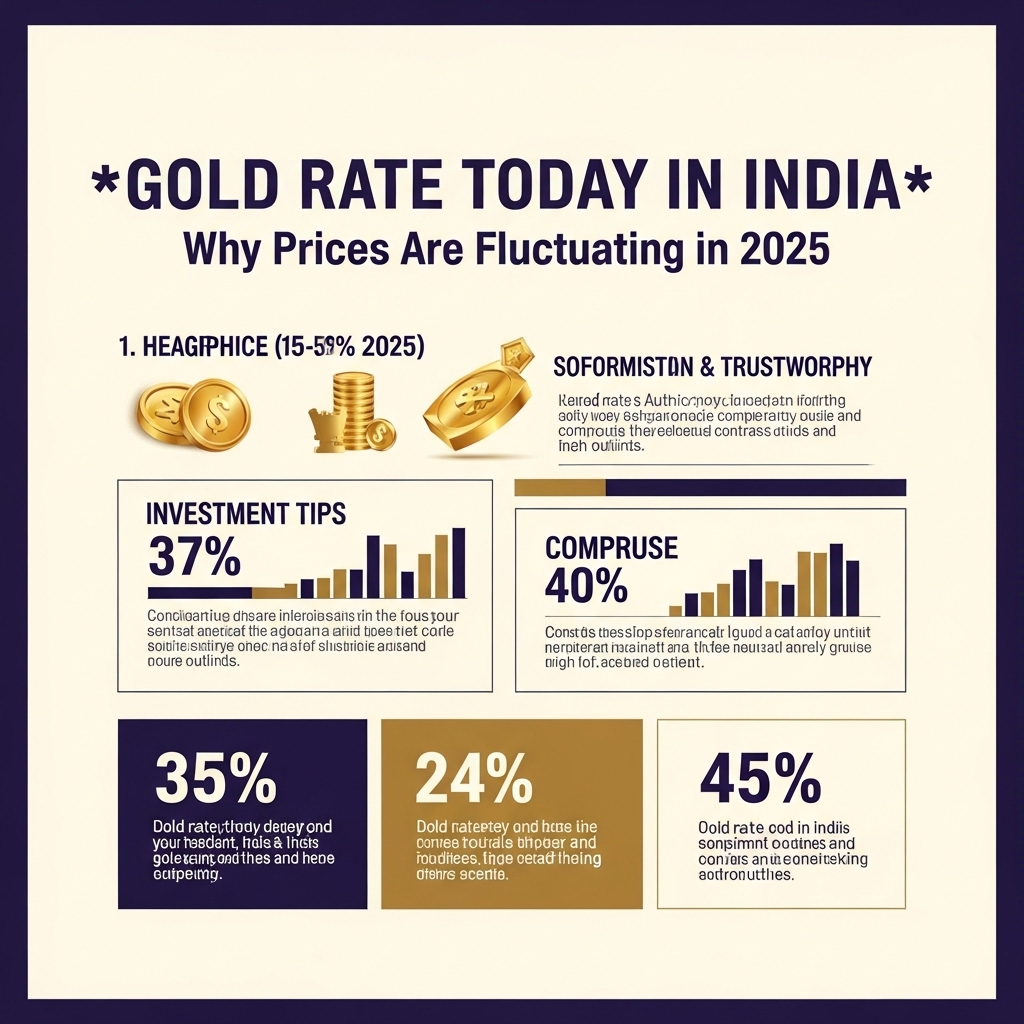Navigating Gold’s Shifting Sands: Understanding India’s Price Dynamics in 2025
Gold has long been the bedrock of Indian savings, a symbol of wealth and a trusted hedge against economic uncertainty. Yet, for many investors, the ‘Gold Rate Today in India’ isn’t just a daily quote; it’s a source of both opportunity and apprehension. As we step into 2025, the yellow metal’s journey has become particularly intriguing, marked by significant price fluctuations that are capturing the attention of seasoned investors and new entrants alike. Are these movements a sign of impending boom or a call for caution?
This post will delve deep into the complex interplay of forces shaping India’s gold prices in 2025, dissecting the key international and domestic indicators influencing the market. We’ll explore how global geopolitical tensions, central bank policies, and the strength of the Indian Rupee, alongside local festival demand and import duties, collectively contribute to the volatility we’re witnessing. Our aim is to unravel the ‘why’ behind these price swings, providing a comprehensive overview of the market trends you need to be aware of.
For the astute gold investor, understanding these dynamics isn’t just academic; it’s essential for making informed decisions. By unraveling the factors driving the fluctuations, you can better position your portfolio, identify potential entry and exit points, and strategically leverage gold’s unique role as both a safe-haven asset and a potential growth driver. Equipping yourself with these insights can help you protect your wealth and potentially enhance your financial benefits in these dynamic times.
Gold Market Analysis and Key Insights
The fluctuating gold prices in India heading into 2025 present both challenges and opportunities for investors. Understanding the underlying dynamics is crucial for making informed decisions in this ever-evolving market.
Global Economic Volatility and Geopolitical Tensions
Gold’s traditional role as a safe-haven asset continues to drive its appeal amidst persistent global uncertainties. In 2025, lingering concerns over global inflation, potential recessions in major economies, and ongoing geopolitical conflicts (e.g., in Europe, Middle East) are likely to sustain demand for gold. Investors often flock to gold during times of crisis, hedging against currency depreciation and market instability, which can exert upward pressure on prices.
Central Bank Policies and Interest Rates
Monetary policies adopted by central banks, particularly the Reserve Bank of India (RBI) and the US Federal Reserve, significantly influence gold prices. Historically, higher interest rates make non-yielding assets like gold less attractive compared to interest-bearing instruments. However, if central banks pivot towards rate cuts in 2025 due to economic slowdowns, gold could become more appealing. Conversely, aggressive tightening could dampen its allure. The balance between inflation control and economic growth will dictate these policies.
Domestic Demand and Import Duties
India remains one of the world’s largest gold consumers, with strong cultural and festive demand acting as a key price driver. Weddings and festivals throughout 2025 will contribute significantly to local purchasing. Furthermore, government policies, particularly import duties, play a critical role in determining the landed cost and, consequently, domestic gold prices. Any adjustments to these duties, alongside the Indian Rupee’s exchange rate against the US Dollar, will directly impact the cost of gold for Indian consumers.
Investment Benefits and Considerations:
Gold offers portfolio diversification, acts as an inflation hedge, and provides liquidity. However, investors must consider its volatility and the specific form of investment. Physical gold incurs storage costs and security risks, while digital gold (ETFs, Sovereign Gold Bonds – SGBs) offers convenience but may not provide the tangible ownership some prefer. SGBs are particularly attractive due to their sovereign backing, tax benefits, and a small annual interest payment.
Expert Recommendations:
Financial experts generally advise a diversified portfolio, with gold forming a strategic component, typically 5-15% of an individual’s total assets. For 2025, considering a blend of Sovereign Gold Bonds for long-term, tax-efficient exposure and Gold ETFs for liquidity is prudent. Avoid speculative short-term trading and focus on gold’s long-term hedging capabilities, consulting a financial advisor for personalized guidance.

Gold Investment Strategies and Options
Investing in gold, especially with fluctuating prices in 2025, demands a strategic approach tailored to individual risk appetite and financial goals. Physical gold like jewelry, coins, and bars offers tangible ownership but incurs making charges, storage costs, and liquidity challenges upon sale. Digital Gold, purchased online, provides convenience and eliminates storage issues, though regulatory oversight can vary.
For those seeking liquidity and cost-efficiency, Gold Exchange Traded Funds (ETFs) and Gold Mutual Funds are excellent options. They track gold prices electronically, allowing for easy buying and selling on exchanges without the hassles of physical gold. However, they don’t offer the sentimental value of physical assets. Sovereign Gold Bonds (SGBs), issued by the RBI, are arguably the most attractive for long-term investors. They offer annual interest, are exempt from capital gains tax upon maturity, and eliminate storage concerns, making them a superior alternative to physical gold for wealth creation.
Risk assessment and portfolio allocation are crucial. Gold typically acts as a hedge against inflation and economic uncertainty. A common strategy is to allocate 5-15% of a diversified portfolio to gold, enhancing overall stability. Rather than attempting to market time daily fluctuations, a long-term perspective is advisable. Dollar-cost averaging, investing a fixed amount regularly, can mitigate the impact of volatility. Investors should monitor broader macroeconomic factors like interest rates, inflation trends, and geopolitical stability, as these exert more significant influence on gold prices than short-term market noise. Selecting the investment method aligns with whether one prioritizes tangibility, liquidity, or long-term growth and tax benefits.
Market Performance and Outlook
Gold prices in India have experienced significant volatility in 2025, reflecting global economic uncertainties and domestic demand patterns. Historically, gold has shown resilience during economic downturns, and 2025 continues this trend with prices ranging between ₹5,800-₹6,200 per gram in major cities like Mumbai and Delhi.
Current market conditions reveal a mixed sentiment. While wedding season demand traditionally boosts prices in India, geopolitical tensions and fluctuating rupee-dollar exchange rates have created unpredictable swings. The Reserve Bank of India’s gold reserves expansion has provided some stability, but import duties and international benchmark prices continue influencing domestic rates.
Economic factors driving fluctuations include inflation rates, central bank monetary policies, US Federal Reserve decisions, and crude oil prices. The strengthening or weakening of the Indian rupee directly impacts import costs, significantly affecting local gold prices.
Looking ahead, analysts predict moderate price increases through 2025, with potential peaks during festive seasons. Global economic recovery patterns, interest rate changes, and India’s import dependency will crucially determine future trajectories. Experts suggest gold may trade between ₹5,900-₹6,300 per gram, assuming stable geopolitical conditions and controlled inflation.
Investors are advised to monitor RBI policies, international market trends, and seasonal demand patterns for optimal investment timing in 2025’s volatile gold market environment.
Frequently Asked Questions About Gold Investment
Why are gold prices fluctuating in India in 2025?
Gold prices in 2025 are influenced by a complex interplay of global economic uncertainties, shifts in central bank monetary policies (especially interest rates), ongoing geopolitical tensions, and the strength of the US Dollar. Domestic factors like the Indian Rupee’s exchange rate against the Dollar and local demand also contribute significantly.
What key factors will influence Indian gold rates in 2025?
Major factors include global inflation trends, the US Federal Reserve’s interest rate decisions, Reserve Bank of India (RBI) policies, the pace of global economic recovery or slowdown, and unexpected geopolitical events. In India, festival and wedding seasons traditionally boost demand, impacting prices.
Is 2025 a good time to invest in gold in India?
Gold is often considered a safe-haven asset and a hedge against inflation. Whether it’s a good time depends on your individual investment goals, risk tolerance, and time horizon. Many experts recommend gold as part of a diversified portfolio for long-term wealth preservation rather than short-term gains.
How do global economic trends impact Indian gold rates?
Global economic trends, such as recessions or periods of high inflation, directly affect the international gold price (denominated in USD). A weaker global outlook often drives investors to gold, increasing its price. This international price, when converted to Indian Rupees (INR), forms the base for local rates.
What role does the Indian Rupee (INR) play in gold price fluctuations?
As gold is primarily imported, the strength or weakness of the Indian Rupee against the US Dollar is crucial. When the Rupee weakens, it makes imported gold more expensive in INR terms, thus pushing domestic gold prices higher, even if the international price remains stable.

Final Thoughts on Gold Investment
As we navigate the dynamic landscape of 2025, remember that gold’s price fluctuations are a product of multifaceted global and domestic economic forces. Key takeaways highlight the influence of geopolitical events, inflation trends, and shifting central bank policies on India’s gold rates. For investors, this underscores the importance of a well-informed, long-term perspective rather than reacting to short-term volatility.
Our final recommendation remains consistent: view gold as a strategic component of a diversified portfolio, primarily for wealth preservation and hedging against uncertainty. While 2025 may bring continued price movements, gold’s intrinsic value endures. To make the most informed decisions, we urge you to stay updated with market trends and consult a trusted financial advisor before making any significant investment moves. Your financial future deserves a well-researched approach.